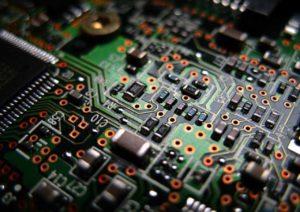Electronics Quiz Questions with Answers – What is Electronics – Electronics GK

Electronics Quiz Questions – Electronics GK Part 1 (Questions 1-15)
1) What do you mean by electronics?
Answer: The study of behavior of electrons, their control and use.
2) The process of adding certain impurities in the crystal structure of a semi-conductor so as to improve its conductivity is called?
Answer: Doping.
3) It is a process of allowing electric current to flow only in one direction that is changing A.C in to D.C.
Answer: Rectification.
4) What is called amplification?
Answer: It is the process of strengthening weak signals.
5) What is oscillation?
Answer: It is a process of conversion of D.C in to a signal of desired frequency.
6) What is liquid crystal?
Answer: They are organic compounds resembling both liquid and crystals.
7) Which of the electronics is known as wonder child of electronics?
Answer: Transistor.
8) Which device work on the principle of thermionic emission?
Answer: Valve.
9) The function of valve depends on the phenomenon?
Answer: Thermionic emission.
10) The third electrode in a triode is known as?
Answer: Control grid.
11) Electricity is not conducted through germanium because the number _?
Answer: Free electrons are comparatively less.
12) The thermionic valve named triode has _?
Answer: 3 electrodes.
13) The impurity to be added to get n-type semi-conductor is _?
Answer: Arsenic.
14) The impurity to be added to get p-type semi-conductor is _?
Answer: Boron.
15) Current conduction in p-type semi-conductor is due to _?
Answer: Holes.
Electronics Quiz Questions – Electronics GK Part 2 (Questions 15-30)
16) Current conduction in n-type semi-conductor is due to _?
Answer: Free electrons.
17) Semi-conductor crystal having an excess of electrons by doping is named?
Answer: N-type semi-conductor.
18) Example of donor is?
Answer: Antimony.
19) Example of acceptor is?
Answer: Gallium.
20) The hole is considered as?
Answer: Equivalent of a positive charge.
21) The process of extracting audio signals from high frequency carrier waive is known as?
Answer: Detection.
22) The upper limit of audibility for a normal human ear is?
Answer: 20000.
23) Detection is a kind of _?
Answer: Rectification.
24) The reverse process of modulation is _?
Answer: Detection.
25) The middle region of transistor is known as?
Answer: Base.
26) The current carriers in PNP transistor consist of _?
Answer: Holes.
27) The current carriers in NPN transistor consist of _?
Answer: Electrons.
28) The device which can be used as an amplifier and an oscillator is _?
Answer: Transistor.
29) A function which cannot be done by a junction of a diode is _?
Answer: Oscillation.
30) Power gain is equal to _?
Answer: Voltage gain x Current gain.
Electronics Quiz Questions – Electronics GK Part 3 (Questions 31-45)
31) For producing high frequency carrier wave we use:
Answer: Oscillator.
32) The vacuum tubes (valves) were discovered by:
Answer: Lee de Forest.
33) The process of broadcasting in which the frequency of radio waves is changed in accordance with the sound signals is known as:
Answer: Frequency modulation.
34) Which is the main part of a tuner in the radio receiver?
Answer: Variable condenser.
35) The process of making a radio receiver sensitive to a particular frequency alone is known as:
Answer: Tuning.
36) During play back of a tape recorder, the tape is drawn past the poles of the head at a constant speed of:
Answer: 5 cm/second.
37) The part of T.V camera which produces the beam required for scanning is called:
Answer: Electron gun.
38) In our T.V. system time taken for scanning one frame is:
Answer: 1/25 second.
39) The rays starting from the cathode discharge tube are called:
Answer: Cathode rays.
40) The scientist who discovered that though gases are not good conductors, high voltage electricity can discharge through gases was:
Answer: William Crookes.
41) The unit used to express wave length is:
Answer: Angstrom.
42) The value of capacitor is expressed in the unit:
Answer: Farad.
43) The waves used in radar can be considered to be:
Answer: Micro waves.
44) Image orthicon is a kind of:
Answer: Pick up tube.
45) Who invented the tunnel diode?
Answer: Leo Esaki.
Electronics Quiz Questions – Electronics GK Part 4 (Questions 46-60)
46) The simplest type of valve is called:
Answer: Diode.
47) The valve having three electrodes is known as:
Answer: Triode.
48) Substances like glass, mica and rubber are called:
Answer: Insulators.
49) In the pure state the semiconductors are known as what?
Answer: Intrinsic.
50) After doping a semiconductor will have good electrical conductivity. In such a stage it will be known as:
Answer: Extrinsic.
51) If a silicon crystal is doped with an element of group five it becomes:
Answer: N-type semiconductor.
52) The impurity used to make p-type semiconductor is:
Answer: Boron or gallium or indium.
53) The majority carriers in n-type semiconductor is:
Answer: Electron.
54) A semiconductor one side of which is doped with a p-type impurity and the other side is doped with n-type impurity is called:
Answer: PN junction diode.
55) What is known as diffused junction?
Answer: The P.N junction obtained by diffusing impurity into the semiconductor crystal.
56) When the P region and N region of a P-N diode are connected to the negative and positive poles of the battery respectively it is said to be in:
Answer: Reverse biased.
57) The process of mixing the audio signals with high frequency carrier waves is called:
Answer: Modulation.
58) Which must have the proper size to match the impedance of the transmitter or receiver to that of space?
Answer: The antenna.
59) What is called the type of modulation in which the frequency of the carrier waves is altered in accordance with the audio signals?
Answer: Frequency modulation.
60) In amplitude modulation which of the carrier wave is changed in accordance with the sound pattern?
Answer: Amplitude.


